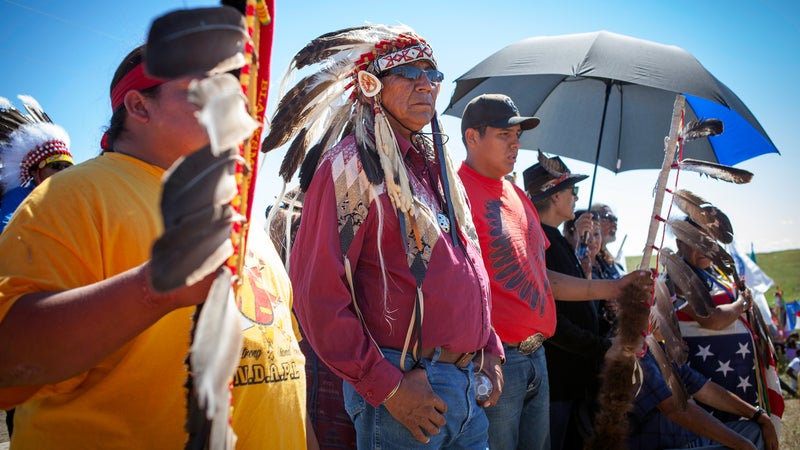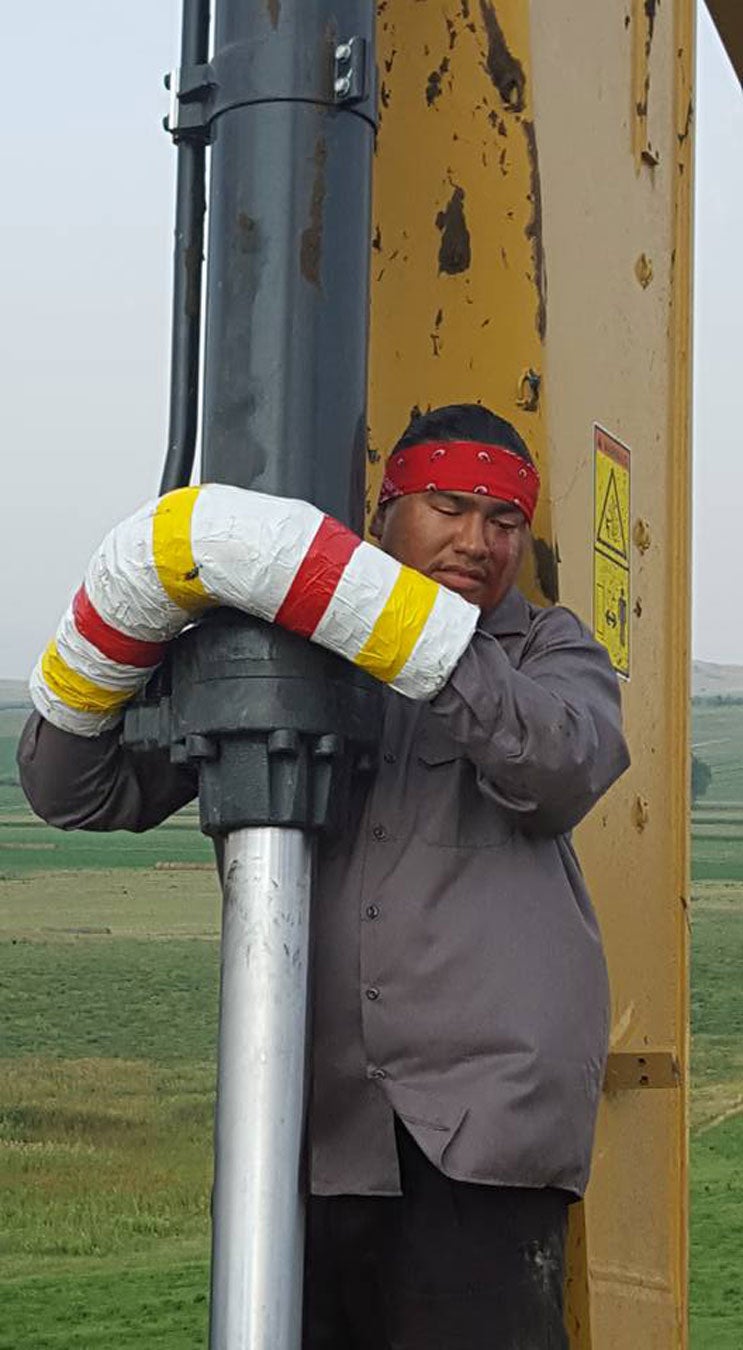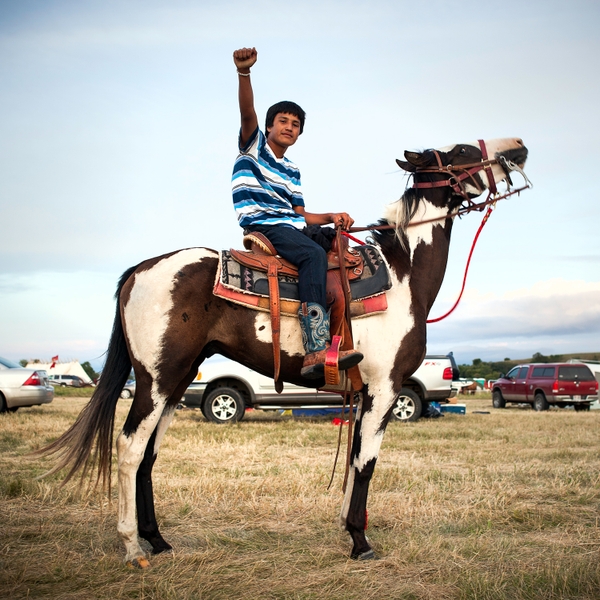What’s Happening in Standing Rock?
Two of our country's biggest issues, racism and climate change, have collided on a North Dakota reservation. This week, I loaded up my station wagon with water and supplies and drove down for a look at a historic demonstration that could shape the national dialogue going forward.
New perk: Easily find new routes and hidden gems, upcoming running events, and more near you. Your weekly Local Running Newsletter has everything you need to lace up! .
Last week, the Standing Rock Sioux Tribe in North Dakota emerged as climate change heroes when, with little political clout or media spotlight, they halted construction of the $3.7 billion Dakota Access oil pipeline. After tribal chairman David Archambault II and others were arrested for pushing past barricades to block excavating machinery, Leonardo DiCaprio tweeted that he was inspired, and Bill McKibben touted Native Americans as the “the vanguard of the movement.” As the tribe sued the U.S. Army Corps of Engineers to stop crews from burrowing beneath the Missouri River immediately upstream from their land, the homely, unpronounceable hashtag #NoDAPL surged—short for No Dakota Access Pipeline.
Meanwhile, the defiance evoked America’s ugly racial past—and present. “It feels like 1875 because Natives are still fighting for our land,” tweeted Native American writer Sherman Alexie. Archambault could have been describing Ferguson or Baltimore when, in the New York Times, he decried racial profiling and claimed that “the state has militarized my reservation.” In a touch of epic derp that would be funny if it didn’t actually reveal how people of color are assumed to be violent, when the Lakota invited relatives to pack their peace pipes and gather with them in solidarity, the (white) county sheriff thought they meant pipe bombs.
By last weekend, several thousand Native Americans from around the country had arrived at Standing Rock, the 3,500-square-mile reservation with 8,250 residents. They were joined by a smattering of earthy white folk and a crew of Black Lives Matters activists from Minneapolis. The camp was just outside the boundary on land administered by the Army Corps. State troopers blocked the highway to Bismarck, allowing protesters—or “protectors,” as they insisted on being called—to leave but not return. In the U.S. District Court for the District of Columbia, the tribe’s lawyers argued that the pipeline would pollute their water and desecrate sacred burial grounds. Judge James E. Boasberg said he would decide in the coming weeks whether to issue an injunction against the corporation building the pipeline, Dakota Access, a subsidiary of Phillips 66 and a Texas company called Energy Transfer.
Sensing a conflagration of America’s two most volatile issues—racism and climate change—I wrenched the backseats from of my station wagon, loaded it with a mattress, five gallons of water, and five days worth of provisions, and drove up to Standing Rock.
Just after sunset, I crested a hill above the Cannonball River, and there, in the flat, grassy bottom, beheld an iconic American sight: two dozen teepees and scores of tents lit by headlights and campfires, sheathed in a mist of tire dust and wood smoke, riders galloping bareback on paint horses. At the central fire ring, I found circles of men pounding drums, surrounded by women who wailed with them in old Lakota song, singing well past midnight, fueled by cigarettes, coffee, and cough drops.
I parked alongside a towering teepee on the riverbank, slept in the car, and in the morning met my neighbors, a delegation of Pawnee elders who had driven 18 hours from Broken Arrow, Oklahoma. The degree to which I didn’t know what I was getting myself into was made clear when Chief Morgan LittleSun, 58, a warm and affable welder and teepee builder, told me that his biggest concern coming up here wasn’t cops—it was the Sioux tribes.
“Pawnee and Sioux hated each other forever,” he said. Even though the tribes had signed a peace treaty, LittleSun had seen hostility at powwows, and even fights.
I asked when the Pawnee and Sioux tribes had made this uneasy peace.
“150 years ago.”

As far as LittleSun knew, this was the first time since then that Pawnee chiefs had traveled this far into Sioux territory. While dates of Indian wars and treaties are history-test minutiae that most white people (like me) tend to forget, LittleSun was one of many Native Americans I met for whom the past was not really dead, as the saying goes, not even past. They rattled off these 19th-century events like they happened yesterday, and this gathering at Standing Rock was occasion for a new round of history making. The site was called Seven Councils Camp, indicating the first time all bands of Lakota had gathered in one place in more than a century. That afternoon, the Crow Nation marched into camp in war bonnets, waving flags, singing and whooping, bearing a peace pipe and a load of buffalo meat, offering the first real reconciliation since 1876, when Crows were scouts for Custer at Little Bighorn, where the U.S Cavalry got its ever-loving ass kicked by the Lakota. At last count, representatives from more than 120 tribal nations had arrived from as far as Hawaii, Maine, California, and Mississippi.
But when I asked LittleSun, whose tribe historically had a proud tradition of stealing horses, if he’d felt uneasy here, he shook his head emphatically, and a smile spread over his face. “This is the greatest thing I’ve ever seen,” he said. All day long, strangers walked into his camp and offered food and firewood and asked which tribe he belonged to, and when he told them, they didn’t flinch but embraced him as a brother, an uncle, an elder. “But when I raised the Pawnee flag on a pole,” LittleSun added with a laugh, “everyone moved their horses to the other side of camp!”
A series of kitchens were open around the clock to feed free meals to about 1,000 people. A microphone was open to just about anyone, and throughout the long, hot days, one wayfarer after another described how wonderful it was to be here, how much it meant to see Native Americans from all the nations gathered in common purpose. While I saw passion and anger and solemnity, the main thing I saw was joy. Travelers were reuniting with long-lost relatives. Parents brought small children, and an impromptu homeschool taught them to ride horses and make fry bread. T-shirts and banners with wry slogans like NATIVES WITH ATTITUDE and STRAIGHT OUTTA PINE RIDGE hinted at youth, pride, and immersion in political pop culture. A truckful of teenage boys rolled past a trio of pretty girls and hollered, hopefully, “What tribe are you from?” There was singing and dancing and praying, sweat lodges and kayaks and swimming—a regular Native American paradise.
Amid the evident pleasure they found in being not a minority but the overwhelming majority, as a white reporter I felt like a buzzkill at the thought of whipping out a pen and pad to ask questions. I hung out mostly at the Pawnee camp, each morning making coffee for my neighbors who’d forgotten to bring a pot. Unlike many tribal nations whose numbers have swelled in the past century, the Pawnee, who were forcibly marched from the Missouri River to Oklahoma, have just 3,482 enrolled members. The chiefs told me that going over the rolls after months when deaths outnumbered births was heartbreaking.
A few days before my arrival, state officials had removed a water truck that was in place for protesters. Perhaps they thought they were dealing with a band of starved hunters who might scare away easily instead of a sovereign nation with its own government, police, EMS, and radio station.
“It feels like 1875 because Natives are still fighting for our land.”
Within hours, the Standing Rock Sioux Tribe had hauled in its own infrastructure: banks of Porta-Potties, water tankers, a disaster response trailer, Dumpsters, ambulances, a refrigerated semi truck. Meanwhile, each delegation arrived with cash and food. Tons of food. I spent a day cooking meatball stew in the main kitchen and discovered, among other abundances, a four-person tent stacked to the ceiling with bags of flour. The tribe also had its own beef production enterprise. The Yakima Nation in Washington chartered a tractor trailer filled with pallets of fresh fruit and bottled water. Small donations were also received: somebody mailed four packets of Lipton noodles. When I asked how long they planned to the stay, most said, “Till the end.”
One day, it got so hot that I drove up the road to check email under the air conditioner of the Prairie Knights Casino and Resort, owned by the tribe. After days talking about spirit and justice under the big open skies, it came as a shock to hedgehog into the chilly dark cave of the casinos, ABBA tunes piped through the speakers, a television twice the size of my car. I watched 58 senior citizens disembark from a motor coach from Bismarck, 58 of them Caucasian, and as they plunked their pensions into the one-armed bandits, I wondered if they knew they were underwriting the civil disobedience down the road.
The only note of standoffishness I detected at Seven Councils was a settlement in a grove of cottonwoods called Red Warrior Camp that had erected a fence around itself and hung signs that read: NO MEDIA. NO TOURISTS. CHECK IN WITH SECURITY. An organizer told me the camp was trained in direct nonviolent action. “Whatever happens in Red Warrior Camp stays in Red Warrior Camp,” she said. When they held an open mic outside the gate, their rhetoric included the same message of togetherness and spirit but with a more militant tone. Its people were younger, quite a few of them white, some wearing camo fatigues and bandannas over their faces. I was told that many of the activists came from Pine Ridge Indian Reservation in South Dakota, home to the Wounded Knee Massacre of 1890 and uprising in 1973, still bearing a stamp of badassery from the days of the American Indian Movement. Unlike the Standing Rock Tribe, which courted mainstream reporters, Red Warrior pumped out its own message on Facebook. I didn’t attempt to penetrate the place but met some young native guys staying there. “For a place calling itself Red Warrior Camp,” one of them quipped, “there sure are a lot of white warriors.”
Nonetheless, in five days I witnessed no violence, lawlessness, alcohol, or even hostility. A couple speakers even welcomed “European relatives” such as myself. The days were filled with peaceful marches and prayers at the idle construction site, ceremonial welcoming of newly arrived tribes, and as afternoon temps rose to the nineties, flinging ourselves into the cool waters of the once-mighty Cannonball. “River” is the incorrect word to describe this body of water. With its currentless murk and silty mud, the thing is a reservoir, an arm of the man-made lake impounded by the Oahe Dam.
“When we need help, they say we are sovereign. But when it comes to development of our resources—oil, gas, coal, uranium, water—then they step in see how much money the state can get.”
I met Nick Estes, a Lower Brule Sioux from South Dakota who remembered that when he was a child, his grandparents told stories about the wonderful Missouri River. “But after the 1940s, the stories stopped.” The Pick-Sloan Missouri Basin Program authorized nine dams—five on Indian land, displacing those who lived along the banks. Standing Rock lost 55,000 acres, while adjacent Cheyenne River Reservation lost 150,000 acres.
“If Dakota Access kills this river,” said Estes, “it will be its second death.”
According to historian Michael Lawson, author of Dammed Indians, “The Oahe Dam destroyed more Indian land than any other public works project in America.” Estes said his elders “died of heartache.”
Indian nations, with their ample resources and limited political power, have often borne the brunt of resource extraction. For the Lakota, the “Black Snake,” as many call the Dakota Pipeline, feels like just one more case of whittling away of their land—which is to say, breaking their treaties. And Indians can’t help but notice that although the reason they keep getting screwed is never acknowledged to be racism, the victims of the various ecological catastrophes through the decades are often members of their race. Between dams, toxic dumps, fracking, oil spills, and atomic bomb tests, the list of injustices against native communities could fill pages.
In 2014, the proposed route of DAPL went through Bismarck, the capital of North Dakota, with roughly 61,000 residents, 92 percent of them white. After the Corps determined that the pipeline could contaminate drinking water, it was rerouted to pass by Standing Rock. “That’s environmental racism,” said Kandi Mossett, of the Mandan, Hidatsa, and Arikara Nation in North Dakota and an organizer with the Indigenous Environmental Network.
This type of outrage is not limited to activists. Jetting in from Arizona was Russell Begaye, president of the 360,000-member Navajo Nation, by far the country’s largest. As the only man on the grounds in a coat and tie (a giant turquoise bolo, to be precise), he looked every bit like the most politically powerful American Indian in the country. When I asked if he thought the placement of projects like DAPL on native land were evidence of racism, Begaye said, “Of course, because they could put this further north, but they are not going to do that because the population up there is not Indian.” He cited the 2015 Gold King Mine wastewater spill on the Animas River in Colorado, which polluted Navajo water and farms.
Much of this debate hinges on a concept to which most non-Native Americans give little thought: sovereignty. According to the treaties, Indians were to be treated as autonomous nations and dealt with diplomatically, like foreign governments. That didn’t happen. Reservations were ruled by unelected white agents from the Bureau of Indian Affairs, who outlawed native language and religion. But in past decades, reservations have established their own governments and, with bands of lawyers, have fought for—and, in many cases, won back—their treaty rights. The Standing Rock lawsuit may hinge on the definition of sovereignty. The law required the Army Corps of Engineers to consult with the tribe before it permitted the pipeline, but it didn’t require that the tribe approve. So Standing Rock contends that its wishes were overruled.
“When we need help, they say we are sovereign,” said Mossett. “But when it comes to development of our resources—oil, gas, coal, uranium, water—then they step in see how much money the state can get.”
The United Nations appears to agree. On Wednesday, its Permanent Forum on Indigenous Issues released a statement that the failure to consult with the Sioux on DAPL violated the Declaration on the Rights of Indigenous Peoples, a resolution President Obama signed in 2010.
For all its notoriety as climate crusaders, the Standing Rock Sioux Tribe did not ask for that mantle. Their lawsuit, in which they are represented by the environmental group Earthjustice, does not mention carbon or fossil fuels. For that matter, it doesn’t mention racism. It focuses strictly on two issues: potential pollution of their water source in the event of a spill and the disturbance of sacred sites. And yet their defiance has stirred the pot, and in this moment of galvanization, other indigenous Americans are bringing to the table ideas that combine the often-estranged progressive causes of ecology and racial justice.
“Climate change is inherently racist,” said Nick Estes, co-founder of activist organization the Red Nation and a PhD candidate in American Studies at the University of New Mexico. “The Anthropocene began with fossil fuel extraction, which began with colonization. The rise of temperatures began with the industrial revolution. And the damage was done to ‘expendable people,’ exploiting the labor of black people and the land of indigenous people.”
There was singing and dancing and praying, sweat lodges and kayaks and swimming—a regular Native America paradise.
Gone is the 19th-century attempt to defeat Europeans or the 20th-century attempt to assimilate. The strategy now is to marshal attorneys, money, land, and political clout to outlast them. “I call us the weebee people,” said Brian Cladoosby, president of the National Congress of American Indians. “We be here when they came, we be here when they gone.”
Perhaps the most startling idea to emerge is a full upending of the narrative of the benevolent—perhaps paternalistic—white liberal uplifting the oppressed minority. People I met here felt that white people had strayed so far from their spiritual core that it was the Indian who would have to rescue them. A Pawnee hip-hop artist who calls himself Quese IMC (born Marcus Frejo Little Eagle), with black beard, hoop earrings, thick-rimmed glasses, and a cocked ball cap, told me that both racism and exploitation of the earth came from the same sickness: a lack of spirituality, which breeds a lack of compassion for other beings. “The earth is a spirit, the water is a spirit, and if you have no spirit, and you have no connection to those things, it will be easy to destroy them and not even care.”
When I asked Chief LittleSun what was so great about the gathering, he said, “The spiritual part of this movement. This ground is the holiest place on earth right now.” This was the first time in his entire life that he’d taken part in any sort of protest or movement. I asked if he considered himself an environmentalist. LittleSun shook his head. “I don’t even know what that is.” It was as if I’d asked him if he were if a “skin-ist” or a “body-ist.” He simply didn’t think of himself as an entity separate from the earth.
Speaking to the main camp circle, Begaye compared the Navajo code talkers who helped defeat Hitler to Native Americans today leading the fight to protect land and water. “We have always saved the white people from themselves!” he declared, and the crowd roared its approval.

With so much celebration in Seven Councils Camp, people hardly noticed that crews were still bulldozing away just miles from the site where they’d been turned back. But the Red Warriors noticed. Before dawn on August 31, two young Lakota men chained themselves to heavy machinery at a pipeline site about 25 miles from camp.
State and county police quickly arrived, blocked the highway, and began trying to extract the men. Dale American Horse Jr., 26, of Sioux Falls, South Dakota, who went by the excellent nickname of Happy, was perched seven feet off the ground, his arms chained to a hydraulic rod that towered high above him. He was a big handsome guy, clean-shaven, with a thick red bandanna tied just above his eyes, covering his black braid. He said little as the firemen attempted to remove him or as a crowd of about 50 supporters sang and drummed and taunted the baby-faced cops.
“Did you ever wear a uniform to defend that Constitution?” jeered an older Indian man, a long gray braid beneath a headband. He sucked a cigarette and blew smoke into the wind, and when the police prevented supporters from smudging American Horse with burning sage, his voice rose. “That’s a religious right we paid for with blood, with the red stripe on the flag! We all wore uniforms! We won wars for you!”
Happy American Horse was extracted and arrested after being locked to the excavator for six hours. Red Warrior spokesperson Clay Hall called the action a success, halting construction for a day and costing the company hundreds of thousands of dollars in delays. “In the Lakota way, we call that counting coup,” he told me. “We took them with an action when they weren’t expecting it.” It’s too soon to say how it will affect the eventual outcome, the relationship between Red Warrior Camp and the Standing Rock tribal government, or what penalty American Horse will pay. Hall said that his group wasn’t merely interested in rerouting the project; they wanted to kill the Black Snake altogether.
But in the short term, the Red Warriors had staged a stunning bit of guerilla theater. Thirteen thousand people watched the action live on Facebook. The picture of Happy American Horse bear-hugging that steel boom went viral. Locked to the pole with a free country behind him, arms bound, eyes cast down serenely, a brown man being handled by white guards: the image that was beamed from America to the world looked all too much like a condemned warrior being led to the gallows. Or to the cross.
�����ԹϺ��������ǰ��������DzԻ��Գ� is the author of . His next book, , will be published by Riverhead Books in January 2017.


